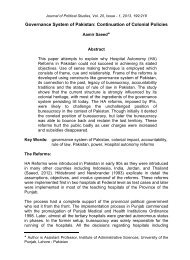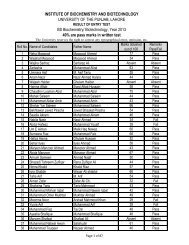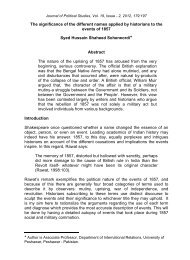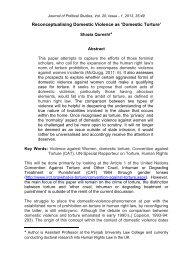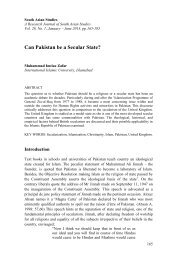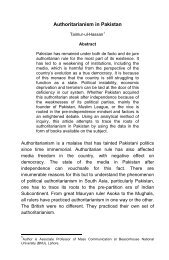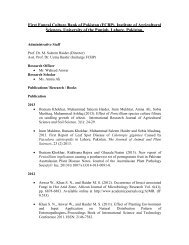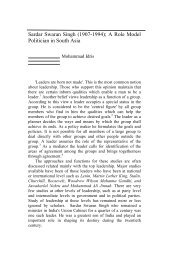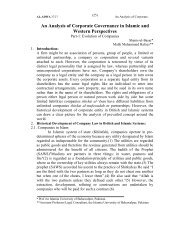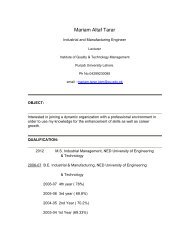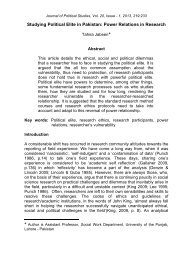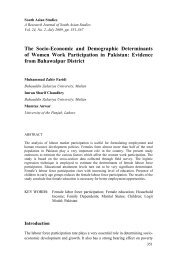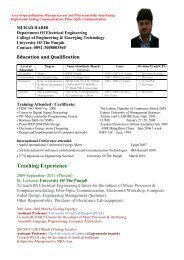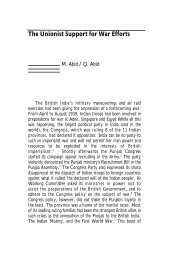pakistan geographical review 1954 - University of the Punjab
pakistan geographical review 1954 - University of the Punjab
pakistan geographical review 1954 - University of the Punjab
You also want an ePaper? Increase the reach of your titles
YUMPU automatically turns print PDFs into web optimized ePapers that Google loves.
and not <strong>of</strong> Mangal Sain. All <strong>the</strong> area covered in this land-use survey belongs<br />
to <strong>the</strong> Warah village except for <strong>the</strong> built up area <strong>of</strong> Kat Mangal Sain which is<br />
bout 30 acres only. The method <strong>of</strong> investigation was partially direct study <strong>of</strong><br />
conditions on <strong>the</strong> spot and partially based on <strong>the</strong> study <strong>of</strong> <strong>of</strong>ficial sources <strong>of</strong><br />
information. This information is contained in four books named M isle-H aqiyat,<br />
Jama Bandi, Kh.aera Gardawri and Lal-Kitab and a village map giving <strong>the</strong><br />
demarcation <strong>of</strong> fields and built up areas. Misle-Haqiyat and Jama-Bandi deal<br />
with <strong>the</strong> ownership <strong>of</strong> land, <strong>the</strong> first giving <strong>the</strong> details <strong>of</strong> ownership before 1940,<br />
<strong>the</strong> year <strong>of</strong> last settlement and <strong>the</strong> latter giving <strong>the</strong> changes which have taken<br />
place since <strong>the</strong>n. For <strong>the</strong> purpose <strong>of</strong> land use, <strong>the</strong>se are not <strong>of</strong> much avaiJ as<br />
<strong>the</strong>se only convey an idea about <strong>the</strong> sub-divisions and fragmentation <strong>of</strong><br />
holdings. Khasra-Gardawri gives detail <strong>of</strong> farms. Lal-Kitab is <strong>the</strong> most<br />
informative <strong>of</strong> <strong>the</strong>se all. It contains information about <strong>the</strong> usage to which land<br />
is put taking <strong>the</strong> village as a whole. It is split into two parts. The first part<br />
gives <strong>the</strong> classifications <strong>of</strong> land in different years under such headings as total<br />
area, area under forests, land otber than forests divided under <strong>the</strong> subheads <strong>of</strong><br />
(a) impossible (b) cultivable, and cultivated fur<strong>the</strong>r subdivided<br />
into kinds <strong>of</strong> land, fallow, double cropped area etc. The second part gives<br />
details about <strong>the</strong> acreage sown to <strong>the</strong> various commodities in Khar if and Rabi in<br />
different kinds <strong>of</strong> land e.g. Chahi, Hail, Barani, Barani Awwal, Miara and Rakkar.<br />
Chahi means well-irrigated. HaiJ is <strong>the</strong> land adjoining <strong>the</strong> village and enriched<br />
by <strong>the</strong> village waste. Barani Awwal is flat low land receiving <strong>the</strong> rain water <strong>of</strong><br />
<strong>the</strong> surrounding area. Maira is <strong>the</strong> upland receiving direct rainwater only and<br />
Rakkar is <strong>the</strong> stony and undulating land consisting <strong>of</strong> coarse material.<br />
The classification <strong>of</strong> land in Warah village is as follows :-<br />
Out <strong>of</strong> <strong>the</strong> total <strong>of</strong> 1,238 acres, 750 acres, as high a percentage as 61, is<br />
totally denied to agriculture and comes under <strong>the</strong> category <strong>of</strong> impossible for<br />
cultivation. About 488 acres 39% is under plough. Out <strong>of</strong> <strong>the</strong> cultivated land,<br />
Hail covers 6 acres, Chahi 18, Barani Awwal 223, Maira 232, and Rakkar 9,<br />
<strong>the</strong> respective percentages being 8.7%. Lx, 45,48-8 and 1.9. It is clear that<br />
Hail, <strong>the</strong> best land, is very small. Chahi being ano<strong>the</strong>r prized kind <strong>of</strong> land is<br />
again very limited. The number <strong>of</strong> wells in <strong>the</strong> village is only three, one<br />
supplying <strong>the</strong> drinking water for <strong>the</strong> village folk, and <strong>the</strong> two irrigating <strong>the</strong><br />
fields. The restriction on <strong>the</strong> number <strong>of</strong> welJs is not imposed by <strong>the</strong> depth<br />
<strong>of</strong> <strong>the</strong> water table which is only 20 ft. here but by <strong>the</strong> fact that wells go out<br />
<strong>of</strong> usage after some time owing to <strong>the</strong> increased brackishness <strong>of</strong> water. Maira<br />
20



